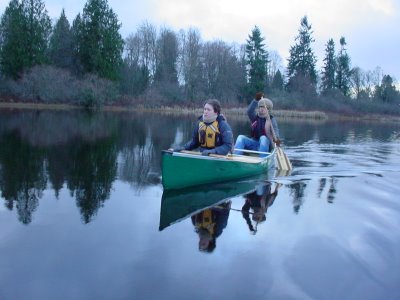 It was late in the afternoon when we took the canoes out on Chambers Lake, about 3:30. This lake, three miles southeast of Olympia, has no surface inlets, but is fed by stormwater and surface runoff. As a result, it varies in size. It is a lake we've paddled at least three times before, and I even thought about trying to fish it from the canoe once, when George was frequenting the nearby bike trails, the 'Rails to Trails' route that is throughout this area. I recall huge carp that would swirl in the water in the summertime, dash away from us and hide under the lilypads.
It was late in the afternoon when we took the canoes out on Chambers Lake, about 3:30. This lake, three miles southeast of Olympia, has no surface inlets, but is fed by stormwater and surface runoff. As a result, it varies in size. It is a lake we've paddled at least three times before, and I even thought about trying to fish it from the canoe once, when George was frequenting the nearby bike trails, the 'Rails to Trails' route that is throughout this area. I recall huge carp that would swirl in the water in the summertime, dash away from us and hide under the lilypads.  It is a small lake, about 60 acres, with a boat-ramp leading down into the water. George is holding the canoe steady here, so Megan can situate herself up front. Normally, we wear garden boots (waders), so we can walk into the water when loading-up. That way, the canoe is further out in the water and won't scrape the bottom when we sit down.
It is a small lake, about 60 acres, with a boat-ramp leading down into the water. George is holding the canoe steady here, so Megan can situate herself up front. Normally, we wear garden boots (waders), so we can walk into the water when loading-up. That way, the canoe is further out in the water and won't scrape the bottom when we sit down.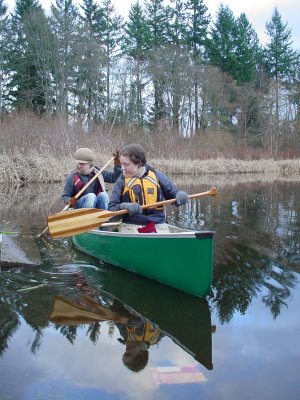 Once situated, they took their paddles and gently pushed away from the cement boat-ramp. If you notice, they are wearing PFD's (personal floatation devices) that zip up, and are form fitting for men or women. I find in winter that they help hold body heat in, and in summer they are sometimes unbearably warm if they are black (like George's).
Once situated, they took their paddles and gently pushed away from the cement boat-ramp. If you notice, they are wearing PFD's (personal floatation devices) that zip up, and are form fitting for men or women. I find in winter that they help hold body heat in, and in summer they are sometimes unbearably warm if they are black (like George's).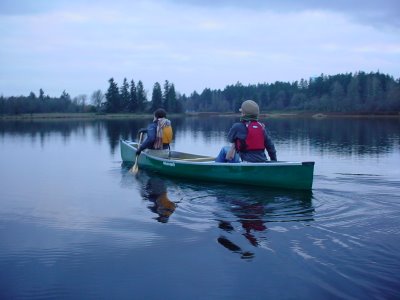 We paddled for only about an hour before the sun started to fade over the hills in a nice rosy glow. We managed to paddle around the lake, with a few little side-trips into the reeds. This is a surprisingly shallow lake - about 8 feet at the deepest - and the roots from lily pads were often within just a few feet from the bottom of the canoe along the shoreline.
We paddled for only about an hour before the sun started to fade over the hills in a nice rosy glow. We managed to paddle around the lake, with a few little side-trips into the reeds. This is a surprisingly shallow lake - about 8 feet at the deepest - and the roots from lily pads were often within just a few feet from the bottom of the canoe along the shoreline. It was fairly cold out, and when you are out on the water it feels even colder. Megan is putting on a hat and her hood here. I spent about 20 minutes filming parts of this glide, which had really lovely, calm water patterns, and deep color. When we loaded up the canoes at the end of our paddle, the sun had set, and little lights twinkled on the shoreline. We had managed to sneak in a delightful little paddle at the end of a busy day.
It was fairly cold out, and when you are out on the water it feels even colder. Megan is putting on a hat and her hood here. I spent about 20 minutes filming parts of this glide, which had really lovely, calm water patterns, and deep color. When we loaded up the canoes at the end of our paddle, the sun had set, and little lights twinkled on the shoreline. We had managed to sneak in a delightful little paddle at the end of a busy day.
 One of the perks of canoeing is meeting other water enthusiasts who show you their boats and share their fishing stories. Steve, pictured above, was just the guy to make our excursion on Lawrence Lake considerably more interesting on Christmas day!
One of the perks of canoeing is meeting other water enthusiasts who show you their boats and share their fishing stories. Steve, pictured above, was just the guy to make our excursion on Lawrence Lake considerably more interesting on Christmas day!
Steve is an Alaska resident who came down here to speed-boat race on Lawrence Lake over the past 20 years. He says Lawrence Lake holds 1/3 of the world's records for speedboat racing.
Although he only works 'crew' on the boats now, he has his own beauty, this fishing boat that he helped to rebuild after his brother smashed it up in a terrible accident on the Talkeetna River. Steve says his boat, a 20 foot Lowe 'Jon Boat', (which can go upstream in 4 inches of water), wasn't fueled up fully when his brother took it up the river. Floodwaters made for some precarious going. When they came across some big log jams that had suddenly piled up they got across several by revving the motor - 'throttling up', as Steve would say. That drained the engine, and depleted the gas. The engine stalled and water got into the motor. Suddenly a 15 foot log jam was right in front of them! The craft flipped and rolled, ripping off the cowls, tearing off the wheel-house, and caving in one entire side of the boat. His brother bailed out alive, but the boat was battered to smithereens. New decks and seats had to be installed, the bodywork had to be welded with aluminum supports and a fiberglass overlay which was then sanded down to make a boat that looked brand new! Steve did all the work, and he was mighty relieved his boat made it through as well as it did.
 While George and Polin loaded up our canoe, I con- tinued to visit with Steve, video- taping many of his stories (yes, these guys are more than happy to have a lady ask them all about their boats and their fishing trips!) He told me that he hopes to go out on the Cowlitz, but that fishing down under is nothing compared to the King Salmon that they get up in Alaska. He said, "If you ever get up to Soldotna, check out Les Anderson's record King mounted on the wall at the Visitor Center - a record 97.4 lbs. Photo here, if you need proof! That fish is as big as a man!
While George and Polin loaded up our canoe, I con- tinued to visit with Steve, video- taping many of his stories (yes, these guys are more than happy to have a lady ask them all about their boats and their fishing trips!) He told me that he hopes to go out on the Cowlitz, but that fishing down under is nothing compared to the King Salmon that they get up in Alaska. He said, "If you ever get up to Soldotna, check out Les Anderson's record King mounted on the wall at the Visitor Center - a record 97.4 lbs. Photo here, if you need proof! That fish is as big as a man!
Now, what does Lawrence Lake have to do with the Mekong Delta? As we headed out on Christmas day, we got a phone call from our friend Polin, who paddled on the Mekong. From Cambodia, in this country for 4 years, he showed interest in going with us.
 To be on the safe side, I packed an extra warm jacket, scarf and hat for him, to make sure he knew what he'd be in for.....I was right. He wouldn't have lasted two minutes out on Lawrence Lake with a thin jacket.
To be on the safe side, I packed an extra warm jacket, scarf and hat for him, to make sure he knew what he'd be in for.....I was right. He wouldn't have lasted two minutes out on Lawrence Lake with a thin jacket.
We paddled slowly over to an island, where we hiked around, exploring old campsites. 
Steve's boat circled around the island a couple of times, making huge waves in the water, and blasting the air with the sounds of his motor.
 I took out my video- camera, to record some of the lichen on rocks, and to videotape Polin and George as they talked about the trees, many names being unfamiliar to Polin. George pointed out the madronas, the tall cedars, the fir.
I took out my video- camera, to record some of the lichen on rocks, and to videotape Polin and George as they talked about the trees, many names being unfamiliar to Polin. George pointed out the madronas, the tall cedars, the fir.
 I bent down with my camera and checked out details.
I bent down with my camera and checked out details.
 This was a large firepit, used last summer by the fishermen. It had a shell-like rotation of stones that was unusual, and as often is the case, brown beer bottles were left behind.
This was a large firepit, used last summer by the fishermen. It had a shell-like rotation of stones that was unusual, and as often is the case, brown beer bottles were left behind.
This time of year, it is more difficult to get a paddling day in. It can be rainy, windy, and cold. Rarely do we see canoers out in the winter. But, if one paddles close to shore, pays attention to the wind, and stays away from moving water (rivers), it is usually quite a pleasant experience. Christmas day offered sunbreaks, no rain or wind. So, conditions made for a good paddle. We kept it down to about an hour, with simple meandering through the tall reeds, spotting a muskrat nest, and enjoying the fresh cold air.
 Polin said that in Cambodia nature is very important - the people love the fresh air, and the river brings food. He said the world of nature is in their poetry, and one of his favorite poems is about a sparrow that flys very far away. The poet asks, "when will you return, little sparrow?"
Polin said that in Cambodia nature is very important - the people love the fresh air, and the river brings food. He said the world of nature is in their poetry, and one of his favorite poems is about a sparrow that flys very far away. The poet asks, "when will you return, little sparrow?"
 With weather in the high 30's, my daily walk has been a bit more challenging. Part of me wants to walk, work up a good appetite, and the other part wants to sit by the fire with a good book! Today, I put together a hearty lunch - homemade lentil soup, flaxseed muffins with butter and honey, hubbard squash with cinnamon and brown sugar, and assorted salad veggies. I made the flaxseed muffins with whole wheat flour, and ground the little seeds in my coffee grinder. The lentil soup is a quick, easy soup to make: Saute the celery, carrots and onions, and add them to vegetable broth, with the lentils, a can of stewed tomatoes , a dash of pepper, lemon juice, a bit of kitchen bouquet, a tad of tomato puree, and cooked sausage or bacon. I add a little brown sugar, salt, and parsley or Italian seasoning. Within 40 minutes, the soup is ready, and the muffins have come out of the oven. These muffins provide amino acids complimenting the ones in the lentils, to make a complete protein - just as your beans and rice combinations. It's a great way to get protein and fiber.
With weather in the high 30's, my daily walk has been a bit more challenging. Part of me wants to walk, work up a good appetite, and the other part wants to sit by the fire with a good book! Today, I put together a hearty lunch - homemade lentil soup, flaxseed muffins with butter and honey, hubbard squash with cinnamon and brown sugar, and assorted salad veggies. I made the flaxseed muffins with whole wheat flour, and ground the little seeds in my coffee grinder. The lentil soup is a quick, easy soup to make: Saute the celery, carrots and onions, and add them to vegetable broth, with the lentils, a can of stewed tomatoes , a dash of pepper, lemon juice, a bit of kitchen bouquet, a tad of tomato puree, and cooked sausage or bacon. I add a little brown sugar, salt, and parsley or Italian seasoning. Within 40 minutes, the soup is ready, and the muffins have come out of the oven. These muffins provide amino acids complimenting the ones in the lentils, to make a complete protein - just as your beans and rice combinations. It's a great way to get protein and fiber.
 And, this is a plate of 'what's left' of the Snickerdoodles that Annie made, with some chocolate truffles dusted in powdered sugar. Truffles should be placed out at room temperature before serving, to inhance the intense aroma and smooth texture as they melt in one's mouth. I seldom settle for only one....
And, this is a plate of 'what's left' of the Snickerdoodles that Annie made, with some chocolate truffles dusted in powdered sugar. Truffles should be placed out at room temperature before serving, to inhance the intense aroma and smooth texture as they melt in one's mouth. I seldom settle for only one....
 When I think of children's books at Christmas-time, I think of the endearing illustrations by Tasha Tudor. She started her career in illustration with the publication of 'Pumpkin Moonshine', published in 1938. She is now 91, still living in New England, and her family runs the business of selling her books.
When I think of children's books at Christmas-time, I think of the endearing illustrations by Tasha Tudor. She started her career in illustration with the publication of 'Pumpkin Moonshine', published in 1938. She is now 91, still living in New England, and her family runs the business of selling her books.
Tasha Tudor has illustrated over 100 books. She is also featured by the photographer Richard Brown in the books here on my bookshelf, which document her daily life, from taking care of her nubian goats and chickens, to growing vegetables in her garden.
Another book, "Tasha Tudor's Heirloom Crafts" by Tovah Martin and Richard W. Brown, features all the handmade items that are an integral part of her legendary nineteenth-century lifestyle. She spins flax, dyes wool, weaves on looms, and makes soap, candles and lotions.  Tasha Tudor does all her illustrations from life, from the field studies around her home. All the fantastic floral borders and blossom-packed wreaths that run around the margins of her books are painted with real-life gatherings from the meadows around her house. She has even known to freeze dead birds and mice, to thaw later as a field study!Tasha Tudor uses fresh goat's milk, eggs, and herbs in her cooking. She held tea parties in the afternoons, and held puppet shows for local children. When asked how she first got started in the culinary arts, she responded, "by making mud pies, as a child." Her family carries on this tradition of afternoon teas by hosting special event teas, already sold out, at the Norman Rockwell Museum in Stockbridge, Maine in December and February.
Tasha Tudor does all her illustrations from life, from the field studies around her home. All the fantastic floral borders and blossom-packed wreaths that run around the margins of her books are painted with real-life gatherings from the meadows around her house. She has even known to freeze dead birds and mice, to thaw later as a field study!Tasha Tudor uses fresh goat's milk, eggs, and herbs in her cooking. She held tea parties in the afternoons, and held puppet shows for local children. When asked how she first got started in the culinary arts, she responded, "by making mud pies, as a child." Her family carries on this tradition of afternoon teas by hosting special event teas, already sold out, at the Norman Rockwell Museum in Stockbridge, Maine in December and February.
 She still cooks by a cast iron stove, and cans tomatos and pears in the fall to put away for winter. Potatoes, squash, and carrots are stored in a root cellar. Apples are collected in the autumn and put through a cider press. When she was a child, that was the beverage served at mealtime.
She still cooks by a cast iron stove, and cans tomatos and pears in the fall to put away for winter. Potatoes, squash, and carrots are stored in a root cellar. Apples are collected in the autumn and put through a cider press. When she was a child, that was the beverage served at mealtime.
Once the gardening season was over, she spent winters illustrating stories, drawing advent calendars, and creating Christmas cards. These are so charming....I hope you will visit her shop, and see what she has to offer during this holiday season.  My favorite is the Sleigh Ride, reprinted from the vintage Tasha Tudor Christmas Card Collection. The interior greeting says: "With warm wishes for the holiday season" Those are my sentiments, exactly.
My favorite is the Sleigh Ride, reprinted from the vintage Tasha Tudor Christmas Card Collection. The interior greeting says: "With warm wishes for the holiday season" Those are my sentiments, exactly.
 This is the view from our window at the Miller Tree Inn, taken at dawn on Sunday morning. I made coffee, and we sat together to greet the morning.The gentle ground fog and the beauty of the sky lingered, but, with freezing temperatures. We were quite comfortable in our room at the Inn, with the firelight from a gas fireplace warming the room.
This is the view from our window at the Miller Tree Inn, taken at dawn on Sunday morning. I made coffee, and we sat together to greet the morning.The gentle ground fog and the beauty of the sky lingered, but, with freezing temperatures. We were quite comfortable in our room at the Inn, with the firelight from a gas fireplace warming the room.
The day before, we drove from Tacoma over to the Olympic Pennsula, to Forks, along Lake Crescent. The areas throughout the Pacific Northwest had just experienced one of the worst storms in recent history. Huge trees had fallen, and debris littered the highway everywhere. Powerpoles and electric lines were being rebuilt, workcrews had taken power-saws to all the splintered trees and local rivers were still sending torrents of rainwater down to the ocean.
It was like traveling through an area hit by a tsunami or a tornado. I've never seen such damage. Sixty- two mile an hour winds and the rainstorms had ravaged the forests and compromised the roadways. Other than the roadcrews cleaning up, very few people were on the roadway - and here we were, heading for an anniversary celebration at the Miller Tree Inn, nested right in the thick of it! We called the owners to see if the Inn 'had power'.  They said they were ready for our arrival, so we chanced the trip. The big tree limbs broken off here were from another storm they had in November.
They said they were ready for our arrival, so we chanced the trip. The big tree limbs broken off here were from another storm they had in November.
Newspaper stories in our area at the time said the Governor had declared a 'state of emergency for western Washington. Also in the news, rescue attempts for the three stranded climbers on Mt. Hood in Oregon were beginning, and magazines had hit the news-stands describing the sad outcome of the James Kim family, lost on a remote logging road up in the mountains. Both stories were filled with tragic outcomes and personal suffering. I felt a little apprehensive as I contemplated our get-away!
As I packed for our trip, I decided to pack emergency items in case we encountered any difficulties along the way - a tent, propane stove, food and water for several days, emergency clothing and bedding. I even packed our huge down comforter, which we ended up using in our room at the Inn! Our room was heated only by a gas fireplace, which we turned off at bedtime (so the room would darken). Come morning, that room was about 46 degrees!
Over the next two days we spent most of our time hiking and exploring beaches. 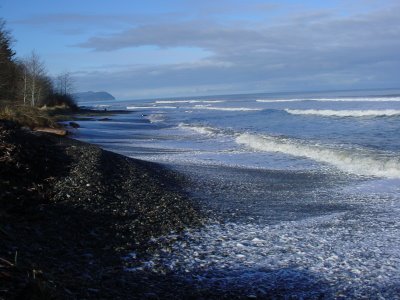 We saw people suited up for surfing and kayaking the large waves in the Strait of Juan de Fuca. People had built a big fire on the beach to stave off the cold temperatures.
We saw people suited up for surfing and kayaking the large waves in the Strait of Juan de Fuca. People had built a big fire on the beach to stave off the cold temperatures.
 This is George at Rialto Beach on the ocean, where we spent several hours walking along the beach. I saw a variety of large fish swept onto the beach - and also a huge stingray. Afterwards, we went into Forks, for a nice dinner at 'The In Place'. I was in the mood for deep fried, lightly battered cod, and George had a steak. There was an exceptionally good salad bar. We were quite fortunate to get such a good meal, as I wasn't sure what the accomodations would be way out in the 'boonies'. A lot of places were closed due to power outages, and some were closed - the heavy tourist season was over.
This is George at Rialto Beach on the ocean, where we spent several hours walking along the beach. I saw a variety of large fish swept onto the beach - and also a huge stingray. Afterwards, we went into Forks, for a nice dinner at 'The In Place'. I was in the mood for deep fried, lightly battered cod, and George had a steak. There was an exceptionally good salad bar. We were quite fortunate to get such a good meal, as I wasn't sure what the accomodations would be way out in the 'boonies'. A lot of places were closed due to power outages, and some were closed - the heavy tourist season was over.
The Inn served Eggs Bennedict for breakfast on Sunday morning, with various fruits, specialty breads, and cereals. We had a hearty breakfast out on a closed-in porch, then scouted out the lakes in the region. I'll have to admit that I forgot my snowpants, which were packed out in the garage somewhere, and the thought of paddling any lake without them, in 32 degree temps, was quite discouraging. Sitting out in the mist, paddling a canoe or filming, just seemed a foolish way to get unbearably cold. I'd rather stay warm in the van, with a laprobe over my legs and a hot beverage in the thermos.
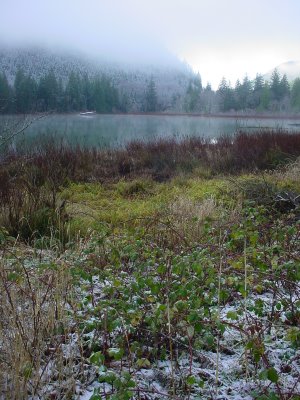 We walked along Beaver Lake here, but given my appre- hensions - it just plain 'felt' spooky - we decided that it would make a better summertime paddle. We took a long hike on the Spruce Railroad Trail on Lake Crescent instead. A work crew was clearing the trail. Power saws, gallon jugs of water and orange juice, and heavy jackets were stashed along the trail.
We walked along Beaver Lake here, but given my appre- hensions - it just plain 'felt' spooky - we decided that it would make a better summertime paddle. We took a long hike on the Spruce Railroad Trail on Lake Crescent instead. A work crew was clearing the trail. Power saws, gallon jugs of water and orange juice, and heavy jackets were stashed along the trail.
The hike was quite chilling at first, but as the trail meandered upward, I warmed up. Unfortunately, our hike was along the shaded part of the mountain, and the sun was pouring warmth and sunshine on the other side of the lake. We hiked through some beautiful forest, coming along a trail over big boulders and a footbridge that basked in the sunshine. We stayed there awhile, to soak up the warmth. (I didn't pack any cameras on this hike.)
Speaking of warmth - Ruhiyyih kept the home fires burning while we were gone. Since power-outages were still all over the Puget Sound area, she invited family members over for a hot meal and showers, and an afternoon of videos and photo albums.  She was also there to greet our friends who were doing the Ruhi study circle, a routine Sunday evening event for us. There is something comforting about returning home, to find family and friends sitting at our fire with a cup of tea, like a little shelter after the storm.
She was also there to greet our friends who were doing the Ruhi study circle, a routine Sunday evening event for us. There is something comforting about returning home, to find family and friends sitting at our fire with a cup of tea, like a little shelter after the storm.
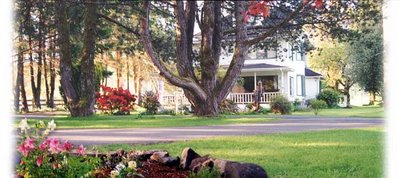
Ruhiyyih writes: "Well, Mom and Dad...30 years is quite the achievement! From the early years in Illinois, to the rambunctious years of living in Big Sky Montana, to new beginnings on Shirley Street in North Tacoma....and now settled in your 'House O' Dreams' on the very fitting Washington Street, we celebrate with you. You have danced, biked, walked, ran, paddled, and drove in a sticker-covered van through the years. We hope that a weekend away at the beautiful Miller Tree Inn on the Olympic Peninsula (where Taraz and Megan honeymooned!) will be a memorable getaway. Your only instructions are to arrive before dusk, and bring your canoe with you--for paddling before you arrive and for all day Sunday (weather permitting!). They serve a full breakfast and yes, Mama--coffee is available! :) You will stay warm by the gas fireplace in your own room, too! We all hope you have a great time, and mark your calendar for the 16th of December! HAPPY 30th Anniversary, Mom and Dad!! Love,
Ruh'ullah & Annie, Taraz'ullah & Megan, Laurel and Mehran, Rahmat'ullah, and Ruhiyyih
 Annie, Rue, Daisy, Megan, Rahmat, Taraz with Mordred, and Ruhiyyih. Our other cat, Pandora, is watching the windstorm outside - gale warnings.
Annie, Rue, Daisy, Megan, Rahmat, Taraz with Mordred, and Ruhiyyih. Our other cat, Pandora, is watching the windstorm outside - gale warnings.
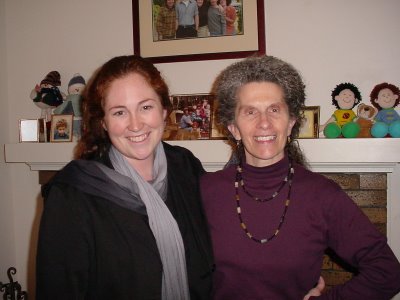 Our daughter, Ruhiyyih, has just flown in from Washington D.C. for a visit through the weekend! I've got a pot-roast cooking, with onions, celery, and carrots; that kiwi salad I enjoyed at Bonnie's; and a chocolate cake. Festivities start, with the whole family, tonite at 6:00.
Our daughter, Ruhiyyih, has just flown in from Washington D.C. for a visit through the weekend! I've got a pot-roast cooking, with onions, celery, and carrots; that kiwi salad I enjoyed at Bonnie's; and a chocolate cake. Festivities start, with the whole family, tonite at 6:00.
 While I was visiting my sister in Montana, she showed me her new hobby - beadmaking collections. She's making necklaces, earrings and bracelets. While I was there, we went to a little shop and purchased our beads. While Bonnie and Mel sorted their beads into trays, organizing and labeling them, I made a necklace out of beads with a coffee-toned (or an Alpine Rubble) appearance. I got the necklace done in about 30 minutes. It is made with elastic clear-plastic thread, shown here next to a slice of fossilized shell.I've planned to start a new hobby too - un-tangling. I'm starting with all the chords exiting my computer, scattered all over the floor behind my desk here. I figure I'll have it all untangled by Spring.
While I was visiting my sister in Montana, she showed me her new hobby - beadmaking collections. She's making necklaces, earrings and bracelets. While I was there, we went to a little shop and purchased our beads. While Bonnie and Mel sorted their beads into trays, organizing and labeling them, I made a necklace out of beads with a coffee-toned (or an Alpine Rubble) appearance. I got the necklace done in about 30 minutes. It is made with elastic clear-plastic thread, shown here next to a slice of fossilized shell.I've planned to start a new hobby too - un-tangling. I'm starting with all the chords exiting my computer, scattered all over the floor behind my desk here. I figure I'll have it all untangled by Spring.
 This is the image from my sister's front window - a panorama of ice and snow, icicles and the long hibernation of winter. It is a comfort to be inside, looking outward, knowing that one is safe and warm.
This is the image from my sister's front window - a panorama of ice and snow, icicles and the long hibernation of winter. It is a comfort to be inside, looking outward, knowing that one is safe and warm.
Outside, the long icicles had reached dangerous lengths, and after filming them, my brother-in-law, Frank, took a straight-edged shovel and knocked all of them down so they wouldn't shatter into the window.
As the week progressed, the snow on the roof began to slide down over the eaves, and the house had a mushroom appearance, with huge drifts covering the roof. The force of gravity had pulled the snow down. When it melts, the icicles will drip until a chinook comes, which will thaw everything. Eventually the precipitation of winter will drip, plop, and thud, down into the grass and bushes surrounding the house.
 Moisture covered everything, with little touches of frost. This is a windowpane holding the moisture in the garage, with just a few scant inches free of moisture.
Moisture covered everything, with little touches of frost. This is a windowpane holding the moisture in the garage, with just a few scant inches free of moisture.
We took a drive into the country on the last day I was in the Flathead Valley, and walked around Lake McDonald in Glacier Park. The roads were plowed, and we walked along the lakeshore.
The huge boulders at the entrance to McDonald Creek were topped with snow and laden with heavy icicles that dripped during the middle of the day.  Little drops of water cascaded down the sides of boulders and dropped into the water. They would mix with other drops and find pathways into the creek which meandered snowbound under sheets of ice.
Little drops of water cascaded down the sides of boulders and dropped into the water. They would mix with other drops and find pathways into the creek which meandered snowbound under sheets of ice.
One day, when we ventured into town, Bonnie, Mel, and I had breakfast with a 73 year old geologist who had done research on volcanic deposits and seismic testing. After this woman got her doctorate, she studied rock formations around an indentation in the ground caused by a meteor. As the ground rippled outwardly, there were bands of different rocks and metals, each distinguished by an upheavel of earth and gravel. Some of these berms were only inches tall, in concentric circles around the impact area.
 It was the geologist's job to carry a gravity-meter, an $18,000 dollar piece of equipment that is used to measure the gravitational pull of the sun and moon on the surface of the earth. She would have to walk very carefully, so as to keep the internal components of the meter in perfect allignment. She also had to position it very carefully, then position herself precariously over the instrument to take the readings. Fractions of inches of the earth's surface were pulled during the 'tides' bearing on the earth. These fractions were recorded, and used as part of her study.
It was the geologist's job to carry a gravity-meter, an $18,000 dollar piece of equipment that is used to measure the gravitational pull of the sun and moon on the surface of the earth. She would have to walk very carefully, so as to keep the internal components of the meter in perfect allignment. She also had to position it very carefully, then position herself precariously over the instrument to take the readings. Fractions of inches of the earth's surface were pulled during the 'tides' bearing on the earth. These fractions were recorded, and used as part of her study.
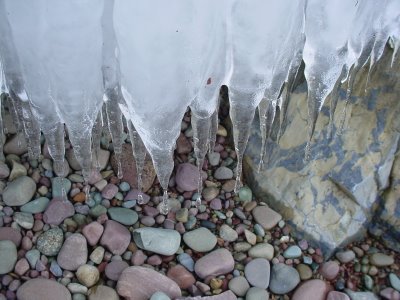 I recently read that each day as many as 4 billion meteors, most miniscule in size, fall to earth. Their masses total several tons, seemingly a large amount, but negligible compared to the earth's total mass of 6,600,000,000,000,000,000,000 tons. It was this geologist's job to measure the rocks strewn by a meteor upon impact.....I think of her now, playing her violin, with her life's work primarily behind her. Had someone walked through the forest, seeing her bent over this space-age looking device, they could have thought she had a few screws loose. I'd enjoy hearing the dialogue as they came tromping nearby, disturbing the sensitive vibrations she was trying to calculate.
I recently read that each day as many as 4 billion meteors, most miniscule in size, fall to earth. Their masses total several tons, seemingly a large amount, but negligible compared to the earth's total mass of 6,600,000,000,000,000,000,000 tons. It was this geologist's job to measure the rocks strewn by a meteor upon impact.....I think of her now, playing her violin, with her life's work primarily behind her. Had someone walked through the forest, seeing her bent over this space-age looking device, they could have thought she had a few screws loose. I'd enjoy hearing the dialogue as they came tromping nearby, disturbing the sensitive vibrations she was trying to calculate.
 This is the trail through the woods that we explored late one afternoon out in Montana. As you can see, the snow was soft and shallow under the trees, but it was abundant out in the open meadows, often a foot deep, and laced with pathways of deer, rabbit, coyote, and wild turkey.
This is the trail through the woods that we explored late one afternoon out in Montana. As you can see, the snow was soft and shallow under the trees, but it was abundant out in the open meadows, often a foot deep, and laced with pathways of deer, rabbit, coyote, and wild turkey.
I videotaped our strolls, showing the depressions in the snow where deer slept, where cabins hunkered down at the edges of meadows, and where rabbits burrowed into snowdrifts.
The air was crisp, and laced with the aroma of woodsmoke, and the snow seemed to muffle all sound, so that it was just the comments of family that kept the pathways company. My sister, dressed in a warm snowsuit, pointed out the solitary spruce that grew down in a culvert, and the hogan that was now covered in a mantle of snow.  We walked until dark, angling out onto a road that lead to a small lake. It had homes along the shoreline, with window-lights shimmering golden upon the water and Canadian geese calling in the distance.
We walked until dark, angling out onto a road that lead to a small lake. It had homes along the shoreline, with window-lights shimmering golden upon the water and Canadian geese calling in the distance.
Twenty years ago, when Bonnie and I took this same winter walk, along the shoreline, I happened to look down, and I saw a solitary piece of paper embedded in the ice. It was a small list of grocery items. I reached down to crack the ice off the paper, to read the list, and much to my amusement, it was a list that I had made earlier in the fall! Bonnie and I had walked along here, and during the walk I must have reached into my pocket for a kleenex, and unknowingly pulled the list out of my pocket where it drifted down onto the shoreline. The onset of a winter storm trapped the paper in ice, and there we were, coming upon it, monthes later. We were so surprised and delighted.
One cannot describe the pleasure of arriving home from a winter walk without mentioning what awaits within the comfort of my sister's home - a warm fire at the hearth, hot coffee and a tasty meal! Just walking briskly out in mountain air seems to add a special zest to food. Bonnie served marvelous meals: Fried zuchinni patties with shredded cheese; sliced green kiwi, Asian pears, purple grapes, provolone cheese, ham, and slivers of carrots on colorful salad greens; chicken paprika; lentil soup with hard-crusted bread on the side; spareribs and onions; brussel sprouts with sweet Gjetost cheese in the white sauce; collard greens with onion and bacon; acorn squash from the garden; marvelous home-made eggrolls filled with tiny shrimp and sprouts; that nutty flavored basmati rice with meat, onion, and celery; smoothies made with strawberries from the garden; homemade pecan pie a la mode; and two chocolate cakes made from scratch using dark, rich Hershey's chocolate! Morning coffee was by French drip, served with raw sugar and half'n'half. In the afternoon, Bonnie made frothy cappachinos with an espresso machine.
Unfortunately, I didn't photograph these meals, but I did videotape many images during my trip, and food preparation and the meals were a significant part of my filming. Bonnie's daughter Mel, and her grandchildren also did some of the cooking. I've since put the film on tape. Abundant mouthwatering images of food preparation are mixed in with the images of landscape, snow and ice, with wild turkeys strutting in pathways through the meadows and stellar jays and chickadees at the bird feeders. 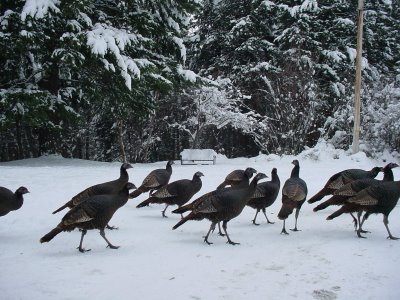 The combinations in my film are like a dance... our walks and then the mealtime preparations. Being snowbound out in the country, that about sums up a daily routine.
The combinations in my film are like a dance... our walks and then the mealtime preparations. Being snowbound out in the country, that about sums up a daily routine.
 I had hoped for tons of snow, something I don't see here in the balmy pacific northwest. The wish was granted, abundantly!
I had hoped for tons of snow, something I don't see here in the balmy pacific northwest. The wish was granted, abundantly!
I had hoped to film my sister Bonnie's history-math-science-English classes, but 'life' happened instead. . . .we played hookey for the complete duration of my visit. Nobody wished to diagram sentences, conjugate verbs, or work out math equasions. World history paled against the lure of wild turkeys, deer, Canadian geese, and the stories of cougar attacks and grizzly bears.We built a snow-woman, strung beads, wandered along an alpine lake in Glacier Park, filmed browsing deer in the forest, studied our ancestors and the family tree, and went to hear the Rocky Mountain Rhythm Kings play at the Snappy Sport Center among all the elk heads, beaver pelts, moose racks, skiis and snowshoes.
Snappy's was kind to allow the director of Camp Heebie Jeebies, Karla West, to bring her band there, so they could practice. When somebody asked the Rocky Mountain Rhythm Kings how often they practice, someone in the band said, "This is it!" They had a piano, guitar, banjo and bass, a cornet, drums, trombone and saxophone - and my brother-in-law, Frank, on the washboard and 'tinklers' - a conglomeration of cymbols and squaks.  They play ragtime jazz, with Linda Ensign as the female vocal lead. She says that her first appearance performing was for the Lutheran Ladies Aid meeting, performing "Jesus Wants Me For A Sunbeam". She also works in vaudeville theatre with her husband, and performs with a modern jazz group. She danced to the ragtime tunes, performing the Charleston.Setting up their sound system, the Rhythm Kings welcomed everyone into the backroom, where folks sat next to one another on folding chairs. I noticed that most of them were retired folks, just like my sister and me, and they all seemed to know one another, talking about their trips here and there to avoid the snow (Phoenix), or to catch up on health issues. It reminded me of the banter at the Roslyn Cafe on that series "Northern Exposure". One of the guys, Don Snow, had to warm things up while setting up the speakers. He read a list of sensible western insights, gleaned over 78 years of rugged Montana living:"Never slap a man who's chewing tobacco.""Never kick a cow chip on a hot day.""Always drink upstream from the herd.""Never miss a good chance to shut up.""Good judgment comes from experience, and a lot of that comes from bad judgment.""If you're riding' ahead of the herd, take a look back every now and then to make sure it's still there.""Lettin' the cat outta the bag is a whole lot easier than puttin' it back." And, on aging, "One must wait until evening to see how splendid the day has been."
They play ragtime jazz, with Linda Ensign as the female vocal lead. She says that her first appearance performing was for the Lutheran Ladies Aid meeting, performing "Jesus Wants Me For A Sunbeam". She also works in vaudeville theatre with her husband, and performs with a modern jazz group. She danced to the ragtime tunes, performing the Charleston.Setting up their sound system, the Rhythm Kings welcomed everyone into the backroom, where folks sat next to one another on folding chairs. I noticed that most of them were retired folks, just like my sister and me, and they all seemed to know one another, talking about their trips here and there to avoid the snow (Phoenix), or to catch up on health issues. It reminded me of the banter at the Roslyn Cafe on that series "Northern Exposure". One of the guys, Don Snow, had to warm things up while setting up the speakers. He read a list of sensible western insights, gleaned over 78 years of rugged Montana living:"Never slap a man who's chewing tobacco.""Never kick a cow chip on a hot day.""Always drink upstream from the herd.""Never miss a good chance to shut up.""Good judgment comes from experience, and a lot of that comes from bad judgment.""If you're riding' ahead of the herd, take a look back every now and then to make sure it's still there.""Lettin' the cat outta the bag is a whole lot easier than puttin' it back." And, on aging, "One must wait until evening to see how splendid the day has been."
 About a month ago, my sister, Bonnie (Bubbie Dear) and her grand-daughter Robyn were standing in front of Granite Park Chalet in Glacier Park. Since then, over a foot of fresh snow has fallen around their cozy home in the Flathead Valley. The bird feeders are full, and they are using their snow plow to get a road out to the main highway. (You have to do that, if you want to get to work on time.) Well, Bonnie's been telling me to visit her this winter - mainly, being retired like me, it keeps some of the winter blahs away. In the Flathead Valley, as here in Tacoma, one grey day can follow another, until 'cabin fever' sets in, and everything gets quite dismal.This winter, Bonnie extended a unique invitation - to monitor, videotape, audit, and enjoy her 'Academy of the Arts and Sciences' held at her kitchen table every day. English, History, Math, Social Studies, and Science are offered for four hours a day, year-long. She is home-schooling her two high school age grand-daughters. Her classes and guidance are suplimented with projects, homework, independent study, and .....playing hookey. Yes! She admitted that they took a day off to drive into town. They shopped for cosmetics, had lunch at Red's Wines and Blues, a fancy restaurant, and did some second-hand shopping at 'The Re-finery'. They browsed through a furniture boutique and ended the day at the Imagination Station, where they bought gifts for Bonnie's grandchildren. The day wore them out, and gave them the sensory overload that one must savor from time to time when living out in the country!When she told me about the lessons and where they explored in town, I figured it was time that I get on a plane and head over there. I'll be in Montana for a week, and when I return home, I hope to have upgraded my Math skills.
About a month ago, my sister, Bonnie (Bubbie Dear) and her grand-daughter Robyn were standing in front of Granite Park Chalet in Glacier Park. Since then, over a foot of fresh snow has fallen around their cozy home in the Flathead Valley. The bird feeders are full, and they are using their snow plow to get a road out to the main highway. (You have to do that, if you want to get to work on time.) Well, Bonnie's been telling me to visit her this winter - mainly, being retired like me, it keeps some of the winter blahs away. In the Flathead Valley, as here in Tacoma, one grey day can follow another, until 'cabin fever' sets in, and everything gets quite dismal.This winter, Bonnie extended a unique invitation - to monitor, videotape, audit, and enjoy her 'Academy of the Arts and Sciences' held at her kitchen table every day. English, History, Math, Social Studies, and Science are offered for four hours a day, year-long. She is home-schooling her two high school age grand-daughters. Her classes and guidance are suplimented with projects, homework, independent study, and .....playing hookey. Yes! She admitted that they took a day off to drive into town. They shopped for cosmetics, had lunch at Red's Wines and Blues, a fancy restaurant, and did some second-hand shopping at 'The Re-finery'. They browsed through a furniture boutique and ended the day at the Imagination Station, where they bought gifts for Bonnie's grandchildren. The day wore them out, and gave them the sensory overload that one must savor from time to time when living out in the country!When she told me about the lessons and where they explored in town, I figured it was time that I get on a plane and head over there. I'll be in Montana for a week, and when I return home, I hope to have upgraded my Math skills.
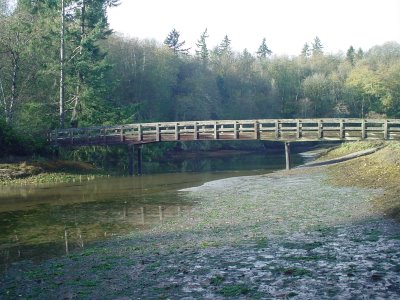 Tolmie State Park is a 105-acre marine day-use park with 1,800 feet of saltwater shoreline on Puget Sound. This forested park is on Nisqually Beach, a few miles from Olympia, the state's capital city.
Tolmie State Park is a 105-acre marine day-use park with 1,800 feet of saltwater shoreline on Puget Sound. This forested park is on Nisqually Beach, a few miles from Olympia, the state's capital city. 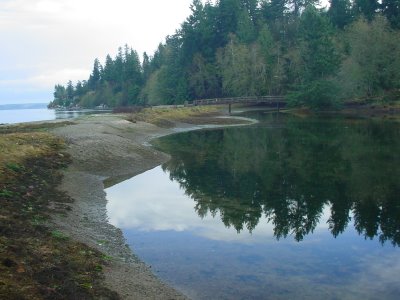 The park features an underwater park for scuba divers, a saltwater marsh, a sand and gravel beach, and a forest of cedar, hemlock, alder, Douglas fir, and maple. The park is named for Dr. William Frazer Tolmie (1812-1866) who spent 16 years with the Hudson Bay Company at Fort Nisqually as a physician, surgeon, botonist and fur trader.With just about an hour of intermittent sunshine on Saturday, we were able to portage the canoe over the sandspit here, and paddle around a far point, before we had to turn back. It was quite brisk out, and with the onset of rain, we had the briefest of canoe paddles.
The park features an underwater park for scuba divers, a saltwater marsh, a sand and gravel beach, and a forest of cedar, hemlock, alder, Douglas fir, and maple. The park is named for Dr. William Frazer Tolmie (1812-1866) who spent 16 years with the Hudson Bay Company at Fort Nisqually as a physician, surgeon, botonist and fur trader.With just about an hour of intermittent sunshine on Saturday, we were able to portage the canoe over the sandspit here, and paddle around a far point, before we had to turn back. It was quite brisk out, and with the onset of rain, we had the briefest of canoe paddles.
 We turned into the inlet as the tide was receeding, letting the current pull the canoe with the tide. It was very shallow, and the golden leaves from the big-leaf maples had fallen into the water.Tolmie State Park is not far from the Nisqually Delta, one of our favorite hiking areas. There is a 5 mile hike out to the delta, and this time of year one can see approximately 4,000-6,000 wintering geese and waterfowl in the wetlands, pastures, and estuary habitats around here.
We turned into the inlet as the tide was receeding, letting the current pull the canoe with the tide. It was very shallow, and the golden leaves from the big-leaf maples had fallen into the water.Tolmie State Park is not far from the Nisqually Delta, one of our favorite hiking areas. There is a 5 mile hike out to the delta, and this time of year one can see approximately 4,000-6,000 wintering geese and waterfowl in the wetlands, pastures, and estuary habitats around here.  Wintering songbirds (Northern shrike, winter wren, golden-crowned kinglet, varied thrush, yellow-rumped warbler, and sparrows) have arrived, and calling out from the willow thickets. On Saturday, we saw a bald eagle preening in a tall tree near the visitor's center.
Wintering songbirds (Northern shrike, winter wren, golden-crowned kinglet, varied thrush, yellow-rumped warbler, and sparrows) have arrived, and calling out from the willow thickets. On Saturday, we saw a bald eagle preening in a tall tree near the visitor's center. 
I remember, one year, we watched 5 immature eagles preening on a sandbank on the delta. That paddle was so windy, we had to drag our canoe across the grassy marsh, and I've never wanted to venture out there again. Two or three summers ago, George wanted to go back, and he explored it with his brother. Of course that was July, not November, and wind gusts then aren't as hazardous as they are in November. We got this day hike in, just before the storm front hit, with snow and temperatures in the low 20's.
 The Nisqually Wildlife Refuge is on the delta. It is a riparian woodland, with huge cottonwoods and big-leaf maples, with non-native grasslands and wetland meadows. McAllister Creek, the Nisqually River and Red Salmon Creek flow through the Refuge and then flow into Puget Sound. Both saltwater and freshwater animals mingle here - the long-tailed weasel, the harbor seals and river otters, mergansers and cormorants.
The Nisqually Wildlife Refuge is on the delta. It is a riparian woodland, with huge cottonwoods and big-leaf maples, with non-native grasslands and wetland meadows. McAllister Creek, the Nisqually River and Red Salmon Creek flow through the Refuge and then flow into Puget Sound. Both saltwater and freshwater animals mingle here - the long-tailed weasel, the harbor seals and river otters, mergansers and cormorants. Many of the apples below this tree had been nibbled by critters, and deer droppings - fresh - were on the ground. The perimeters of the dike have large stands of blackberry canes, rosehips, and crabapples which attract evening grosbeaks and cedar waxwings.
Many of the apples below this tree had been nibbled by critters, and deer droppings - fresh - were on the ground. The perimeters of the dike have large stands of blackberry canes, rosehips, and crabapples which attract evening grosbeaks and cedar waxwings. The calls of birds were everywhere - especially the thrushes, juncos, and flickers. I thought since it was lightly raining, everything would be hushed and still, but the sounds were robust and celebratory.
The calls of birds were everywhere - especially the thrushes, juncos, and flickers. I thought since it was lightly raining, everything would be hushed and still, but the sounds were robust and celebratory.  A storm front was coming in, and with it, snow and dropping temperatures. The Canadian Geese here were in the thousands, flocking up, and feeding in the grass. The shallow seasonal marshes, which dry out in summer, refill in the fall and winter, and are prime feeding areas for these migrating birds.
A storm front was coming in, and with it, snow and dropping temperatures. The Canadian Geese here were in the thousands, flocking up, and feeding in the grass. The shallow seasonal marshes, which dry out in summer, refill in the fall and winter, and are prime feeding areas for these migrating birds.
 These two old barns, built around 1903, were once part of Alson Brown's farm, which had a dike around 1,000 acres. This kept the saltwater out, and provided pastureland for his cattle. In recent years the land has been allowed to become the delta floodplane again, and the texture of the land is reverting back to the way it originally was a hundred years ago. The old barns are now used as educational labs and research stations. An Environmental Education Coordinator is available to meet with teachers and group leaders to help plan field trips for students interested in learning about the cultural history of the watershed, the cycles of nature, birds and migration cycles, and endangered species.
These two old barns, built around 1903, were once part of Alson Brown's farm, which had a dike around 1,000 acres. This kept the saltwater out, and provided pastureland for his cattle. In recent years the land has been allowed to become the delta floodplane again, and the texture of the land is reverting back to the way it originally was a hundred years ago. The old barns are now used as educational labs and research stations. An Environmental Education Coordinator is available to meet with teachers and group leaders to help plan field trips for students interested in learning about the cultural history of the watershed, the cycles of nature, birds and migration cycles, and endangered species. We've lived here for 19 years now, and hiked along the thickets, the boardwalks, and along the dike at least twice a year, during the summer and fall. It is one of our favorite places. That is George in the distance, in full rain-gear, checking out a blue heron.
We've lived here for 19 years now, and hiked along the thickets, the boardwalks, and along the dike at least twice a year, during the summer and fall. It is one of our favorite places. That is George in the distance, in full rain-gear, checking out a blue heron.
 It was late in the afternoon when we took the canoes out on Chambers Lake, about 3:30. This lake, three miles southeast of Olympia, has no surface inlets, but is fed by stormwater and surface runoff. As a result, it varies in size.
It was late in the afternoon when we took the canoes out on Chambers Lake, about 3:30. This lake, three miles southeast of Olympia, has no surface inlets, but is fed by stormwater and surface runoff. As a result, it varies in size.  It is a small lake, about 60 acres, with a boat-ramp leading down into the water. George is holding the canoe steady here, so Megan can situate herself up front. Normally, we wear garden boots (waders), so we can walk into the water when loading-up. That way, the canoe is further out in the water and won't scrape the bottom when we sit down.
It is a small lake, about 60 acres, with a boat-ramp leading down into the water. George is holding the canoe steady here, so Megan can situate herself up front. Normally, we wear garden boots (waders), so we can walk into the water when loading-up. That way, the canoe is further out in the water and won't scrape the bottom when we sit down. Once situated, they took their paddles and gently pushed away from the cement boat-ramp. If you notice, they are wearing PFD's (personal floatation devices) that zip up, and are form fitting for men or women. I find in winter that they help hold body heat in, and in summer they are sometimes unbearably warm if they are black (like George's).
Once situated, they took their paddles and gently pushed away from the cement boat-ramp. If you notice, they are wearing PFD's (personal floatation devices) that zip up, and are form fitting for men or women. I find in winter that they help hold body heat in, and in summer they are sometimes unbearably warm if they are black (like George's).
 It was fairly cold out, and when you are out on the water it feels even colder. Megan is putting on a hat and her hood here.
It was fairly cold out, and when you are out on the water it feels even colder. Megan is putting on a hat and her hood here. 














































